Ammolite is a rare and opalescent organic gemstone predominantly found along the eastern slopes of the Rocky Mountains of North America. This unique and striking gem is derived from the fossilized shells of ammonites, with its composition being mostly aragonite, the same mineral found in nacre. Due to its remarkable color properties and scarcity, Ammolite has become highly sought after for use in jewelry as well as in decorative pieces.
This fascinating gemstone is primarily sourced from the Bearpaw Formation in Alberta, Canada, where the mineral-rich environment allows for the formation of Ammolite’s iridescent hues and patterns. The mesmerizing color spectrum displayed in Ammolite is a result of the intricate layers of aragonite, accompanied by other elements such as silica, calcite, and pyrite. Typically used for cabochons and assembled jewelry, Ammolite continues to captivate admirers with its vibrant and ever-changing appearance.
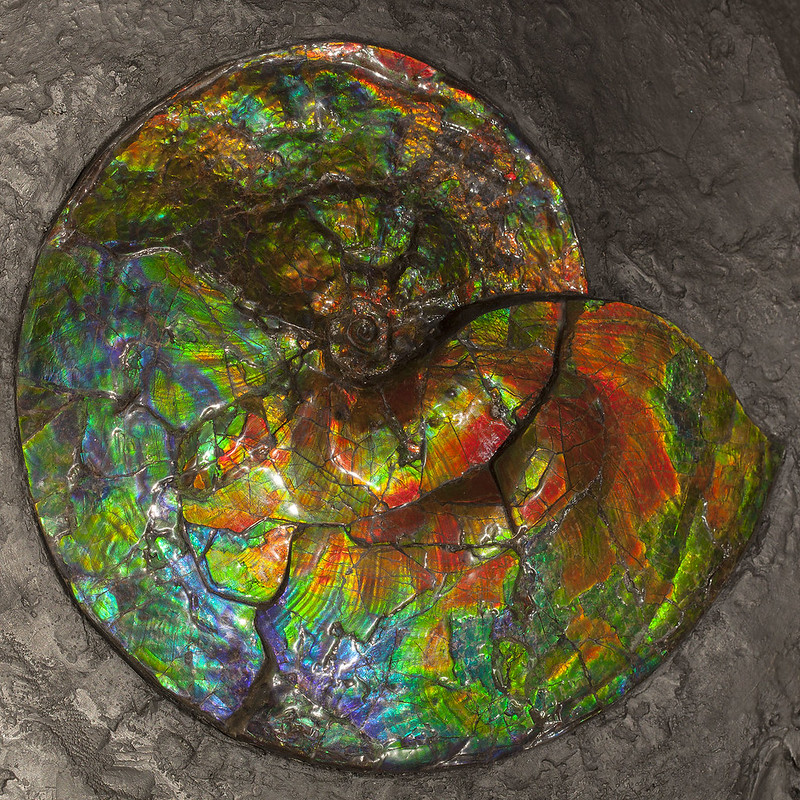
As the market for Ammolite jewelry and fossils grows, so does the appreciation for this one-of-a-kind treasure. With its spellbinding array of colors, unique origins, and a connection to the prehistoric world, Ammolite is a gemstone that invites curiosity and admiration, making it a valuable addition to collections and a striking focal point in jewelry design.
Formation and Geology
Ammonites, which belonged to the phylum Mollusca and the class Cephalopoda, were marine animals that lived millions of years ago, during the Late Cretaceous period.
Read More: What Are Ammonite Fossils? A Brief Overview of The Intriguing World of Ammonites
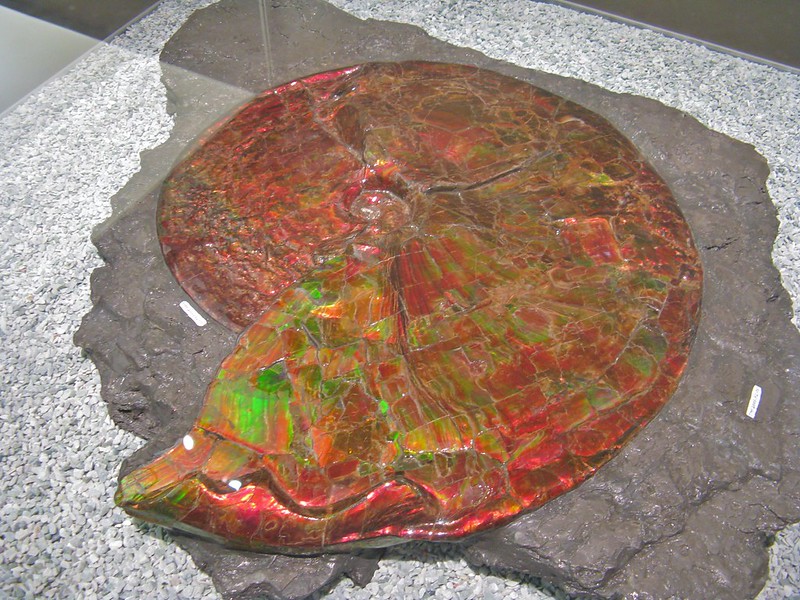
The formation of ammolite began approximately 70-75 million years ago when forces within the Earth were building the Rocky Mountains. The area on the east side of the mountains was covered by a broad body of water known as the Western Interior Seaway. Sediments from this ancient seaway are responsible for preserving the ammonite fossils that eventually transformed into ammolite.
Ammolite is composed primarily of aragonite, a mineral commonly found in nacre, which forms the iridescent layer in the ammonite shell. Its microstructure, inherited from the original shell, creates the opal-like appearance and the stunning play of colors that makes ammolite so appealing. The gemstone is classified as biogenic, placing it in the company of other organic gemstones such as amber and pearl.
The majority of ammolite is sourced from the Bearpaw Formation in Southern Alberta, Canada, which dates back to the Late Cretaceous age. In this region, well-preserved ammonite shells have transformed into ammolite, showcasing an extraordinary display of iridescence. As the iridescent layer of ammolite is generally thin and fragile, most ammolite gems are fashioned into assembled stones for jewelry and decorative purposes.
Properties and Characteristics
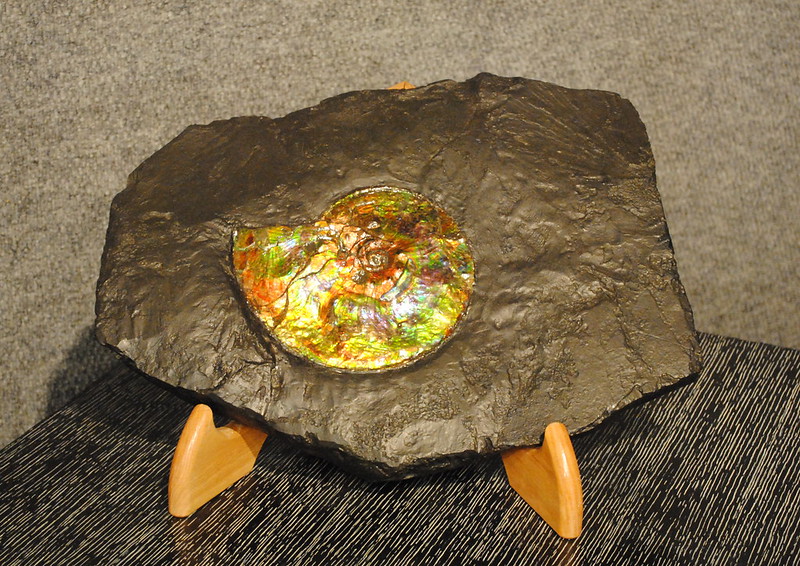
Color Patterns
Ammolite is known for it’s enthralling tapestry of vibrant color patterns. As the iridescent fossilized shells of ancient ammonites, these exquisite treasures boast a myriad of hues, ranging from fiery reds and electric greens to soothing blues and ethereal purples. Their unique chromatic display stems from the delicate layers of aragonite, the same mineral that imparts the lustrous sheen to pearls and nacre. The interplay of light with these microscopic layers results in an optical phenomenon known as ‘interference,’ which is responsible for ammolite’s iconic color-shifting appearance.
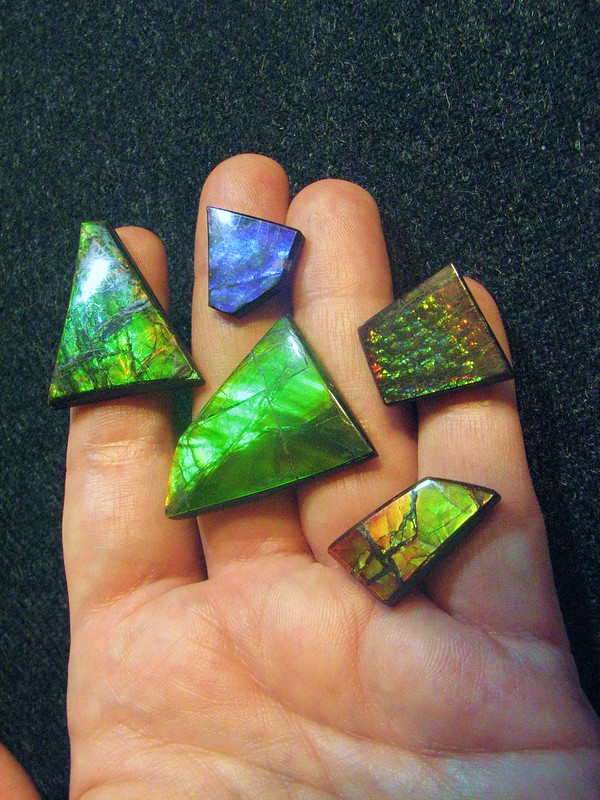
Hardness and Durability
The color-producing shell layer of Ammolite is often very thin, typically less than one millimeter, and adheres to a dark gray to brown shale or siderite base. Due to this thin layer, most Ammolite used in jewelry requires stabilization to ensure its durability. Exceptional pieces, however, can be cut into gems without the need for additional support.
Ammolite’s hardness ranges from 4.5 to 5.5 on Mohs scale, making it a relatively soft gemstone. Care should be taken when wearing Ammolite jewelry to avoid scratching or damaging the stone.
Ammolite Mining and Production
Notable Mining Locations
The Bearpaw Formation in Alberta is the only place where ammolite gemstones are found in significant quantities. The mining operations in this region are dominated by Korite, a Canadian company that accounts for approximately 90% of the world’s gem ammolite production. Korite’s jewelry and home décor items featuring ammolite are available in over 28 countries.
Extraction Techniques
Prospectors interested in mining ammolite deposits on Crown land are required to apply for a lease through the Alberta Department of Energy. Once the lease is obtained, the extraction process begins with careful removal of overburden and preservation of the ammonite fossils. The gem-bearing ammolite layers are then separated and prepared for further processing.
In order to maintain the delicate structure of the ammolite, the gemstone is typically stabilized with a protective backing or epoxy resin during the cutting and polishing process. This helps preserve the brilliant iridescence and color display that makes ammolite such a sought-after gemstone.
Uses and Applications
Ammolite is a unique and fascinating gemstone with a variety of applications. In this section, we will discuss its use in jewelry design, its role in Feng Shui, and its spiritual significance.
Jewelry Design
Ammolite is a highly prized gemstone due to its vibrant colors and unique iridescence. It is often cut and polished into cabochons or faceted stones, and used in various types of jewelry. Because of its fragility, ammolite is best suited for pendants, earrings, and brooches rather than rings or bracelets, which may experience more wear and tear.
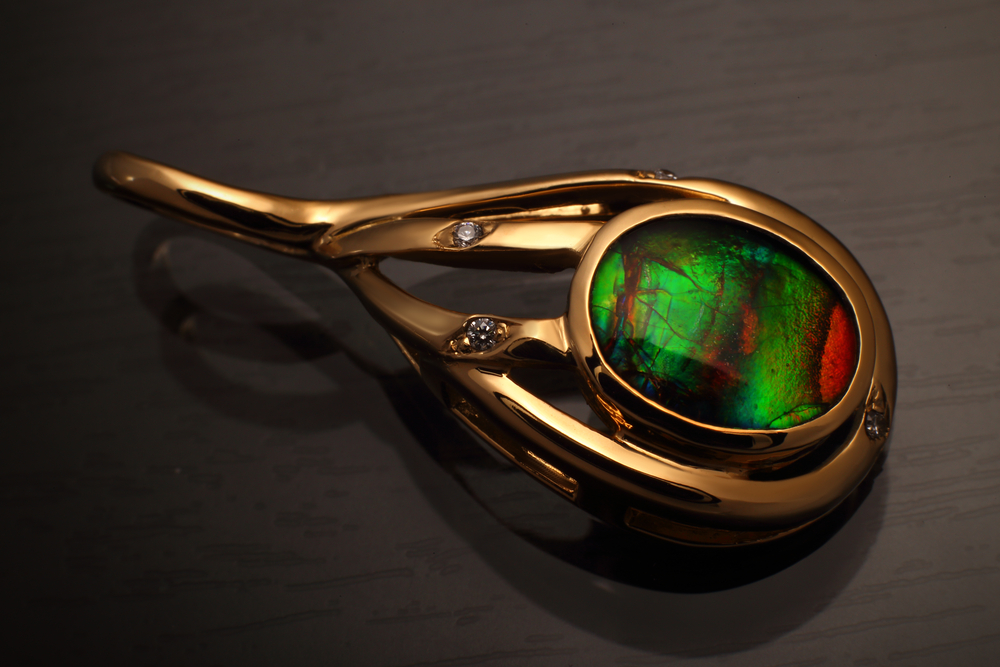
Exceptional ammolite pieces can be cut into gems without stabilization, while most ammolite is used to produce triplets. These triplets consist of a thin layer of ammolite attached to a dark gray to brown base of shale or siderite, offering both beauty and durability to the finished jewelry piece.
Feng Shui
In Feng Shui, ammolite is believed to possess powerful energy that can promote harmony and balance within a space. Its vibrant colors, which resemble the fiery energy of the earth, are thought to stimulate the flow of chi, or life energy. This makes ammolite a popular choice for decorative objects and artwork, as well as for use in energy-cleansing rituals.
As a symbol of prosperity and abundance, ammolite is often placed in the wealth and money area of a home or office to attract financial success. Additionally, its calming, balancing properties are said to be useful in creating more peaceful, relaxing spaces within the home.
Spiritual Significance
Ammolite is also associated with various metaphysical and healing properties. It is said to help release stress, improve performance, and heal pain from past lives. Meditating with ammolite can aid in calming chaotic environments and removing negativity from the human biofield, facilitating clearer communication and smoother relationships.
Other reported benefits of ammolite include its ability to stabilize the pulse, overcome degenerative disorders, and clear blocked energy from the body’s meridians. As a talisman of love, it is believed to foster stable, loving partnerships and enhance one’s overall well-being.
Grading and Value
Factors Affecting Ammolite Quality
Ammolite’s value depends on several factors that determine its overall quality. While there is no universal grading system in place, the industry commonly refers to color, brightness, iridescence, and other qualities when assessing this gemstone.
Color is the most important factor in ammolite quality. The gemstone’s iridescence and chromatic shift also play significant roles in determining its value. Ammolite contains layers of aragonite crystals, with refractive indices ranging from 1.525 to 1.670, which can impact its brightness and appearance.
Another aspect to consider is the hardness of ammolite. It is relatively soft compared to other gemstones, scoring a 3.5 on the Mohs Hardness Scale. This fact can be a concern for potential jewelry buyers, as it may impact the stone’s durability.
How Much is Ammolite Worth?
Ammolite prices can vary greatly depending on the specific piece’s factors mentioned above. In general, ammolite jewelry can cost anywhere from $50 to $500. Prices for ammonite fossils, which can display ammolite’s iridescence, are even more diverse.
Small, lower-quality ammonite fossils may cost less than $10, while large, high-quality pieces with striking iridescence can fetch upwards of $50,000. Institutions like the International Gem Society (IGS) provide value listings and price guidelines for ammolite naturals, doublets, and triplets to assist buyers in determining a piece’s worth.
Care and Maintenance For Ammolite
Ammolite, an organic gemstone, requires proper care and maintenance to preserve its beauty and unique iridescent qualities. This delicate gemstone is quite soft which in turn makes it sensitive to harsh treatments and chemicals.
When cleaning ammolite, it is crucial to avoid using steam cleaners or ultrasonic cleaners, as these can damage the gemstone. Instead, simply polish the gemstone gently with a non-abrasive cloth. This will help remove body oils and grime, keeping the ammolite gleaming.
As for the settings and metal components of ammolite jewelry, tarnish may occur over time, especially with sterling silver. To remove any tarnish, use a soft, non-abrasive cloth and carefully clean the metal parts around the ammolite.
It is important to always be gentle when handling ammolite jewelry. It is best to remove it during activities with high levels of physical contact or exposure to abrasive materials. Make sure to remove your ammolite ring before washing your hands frequently or using hand sanitizers, as these chemicals can potentially damage the stone.
Proper storage of ammolite jewelry is essential for its longevity. Store it separately from other gemstones and jewelry pieces in a soft pouch or lined jewelry box to prevent contact and scratches.
Final Thoughts
Ammolite, a rare and stunning gemstone, offers a unique connection between the natural world and human history due to its origin in the fossilized shells of ancient ammonites. This spectacular stone not only captivates with its iridescent beauty but also serves as a powerful healing crystal with numerous metaphysical properties.
As a fossil gemstone, ammolite stands as a testament to the wonders of our planet’s geological past, encapsulating the mysteries of the deep and honoring the legacy of the majestic ammonites. Its stunning play of colors and remarkable qualities make it a sought-after treasure for collectors, crystal healers, and jewelry enthusiasts all over the world.
See This Incredible Ammolite Collection
- Online rock and mineral club for collectors of all levels!
- Find community with like-minded rock and mineral enthusiasts.
- Monthly Giveaways!
- Free Access to Entire Digital Library of Products (annual memberships)


